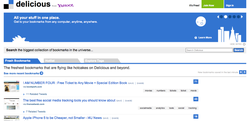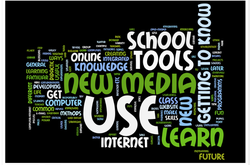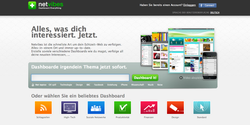My Experience with New Online Tools

Delicious
During the last seven weeks of class, we got acquainted with a great number of different online tools. In order to make use of them in a meaningful sense, it is very important to consider some advantages and disadvantages of them. Personally, I liked some of the tools I got to know much more than others. This is why I will probably not make use of them to the same extend. This implies that personal preferences decide which online applications are being used more frequently than others.
The first sessions were determined under the headline to create our own "Personal Learning Environment" (PLE). To do so we worked with a number of different online tools and web pages. Some of them are presented in the following:
Tools that I liked and that I try (or will try) to use frequently
One part of creating our PLE was the use of social bookmarking. In general, social bookmarking is a method in order to organize, save, search and manage useful online resources.This is an easy way to exchange information about valuable online resources and to share one's experiences with others. We all had to create an account on the social bookmarking tool DELICIOUS. With this tool, one can save bookmarks online and share them with others. Delicious also shows what the most popular bookmarks are at the moment. I consider this tool being very useful as one can profit a great deal of bookmarks from other people as well. Once starting to browse other person's bookmarks, one can easily spend hours in front of the computer and being fascinated by what interesting web pages the Internet provides.
The first sessions were determined under the headline to create our own "Personal Learning Environment" (PLE). To do so we worked with a number of different online tools and web pages. Some of them are presented in the following:
Tools that I liked and that I try (or will try) to use frequently
One part of creating our PLE was the use of social bookmarking. In general, social bookmarking is a method in order to organize, save, search and manage useful online resources.This is an easy way to exchange information about valuable online resources and to share one's experiences with others. We all had to create an account on the social bookmarking tool DELICIOUS. With this tool, one can save bookmarks online and share them with others. Delicious also shows what the most popular bookmarks are at the moment. I consider this tool being very useful as one can profit a great deal of bookmarks from other people as well. Once starting to browse other person's bookmarks, one can easily spend hours in front of the computer and being fascinated by what interesting web pages the Internet provides.

Expectations
Two very similar tools on how to visually present texts or words are WORDLE as well as TAGXEDO. With those tools, one can create so-called word clouds from any text provided. Any text, for example a song, a speech, or just some keywords, can basically be turned into a word cloud. Those words of greater appearance of the given text are marked more prominent than others. Especially tagxedo but also wordle provide a number of different layouts, some of them are really fancy, from which one can choose. I like those tools very much as it is very easy to use them even in class. I imagine that teachers can use them specifically when analyzing speeches or songs just to give the students an idea what the content might be mainly about. Our instructor, for example, used wordle to visualize our expectations of the class as you can see on the picture on the right.
Tools for collaborative working or brainstorming
In order to collaboratively work together in a group, we tried the online tools TITANPAD. This tool enables different group members to actually "talk" to each other but to stay at their individual computer. TitanPad creates some kind of a public document and every group member with the right link can contribute to the development of an actual document. A "time slider" even makes it possible to later follow the course of the creation of the end-result. However, I would not use this tool with a group that is too big as it can get very confusing with too many people writing about the same topic. But it surely is very useful to get some basic ideas about something. Another great advantage is also that students could even work on the same document from home which means they do not even have to be in the same room.
A tool which is very suitable for some brainstorming is BUBBL.us. Bubbl.us is an online mind-mapping tool. Different bubbles can be created and filled with relevant content. It is very self-expanatory and easy to use even when one is not familiar with it. A group, or an individual person, can quickly draw a mind-map about a specific topic. However, this tool as well has its limitations as one cannot, for example, change the size of the bubbles. Thus, if one wants to maybe point out one aspect more than another one, it is not that easy to visualize this just by the bubbles themselves.
Tools for collaborative working or brainstorming
In order to collaboratively work together in a group, we tried the online tools TITANPAD. This tool enables different group members to actually "talk" to each other but to stay at their individual computer. TitanPad creates some kind of a public document and every group member with the right link can contribute to the development of an actual document. A "time slider" even makes it possible to later follow the course of the creation of the end-result. However, I would not use this tool with a group that is too big as it can get very confusing with too many people writing about the same topic. But it surely is very useful to get some basic ideas about something. Another great advantage is also that students could even work on the same document from home which means they do not even have to be in the same room.
A tool which is very suitable for some brainstorming is BUBBL.us. Bubbl.us is an online mind-mapping tool. Different bubbles can be created and filled with relevant content. It is very self-expanatory and easy to use even when one is not familiar with it. A group, or an individual person, can quickly draw a mind-map about a specific topic. However, this tool as well has its limitations as one cannot, for example, change the size of the bubbles. Thus, if one wants to maybe point out one aspect more than another one, it is not that easy to visualize this just by the bubbles themselves.

Netvibes
Tools that I did not like or that I probably will not use in my future
In the context of publishing pictures on the Internet, we all created an account on FLICKR. This tool enables the user to upload digital pictures or videos on a personal account and to share those with other users. One can create photo streams and can decide if those can be seen by the public or not. The use of this application is quite self-explanatory. However, I still do not like the idea having a special platform for sharing pictures with other people. Even if one can determine what pictures can be seen by who, I do not really see the reason why I need such an account.
We also created our own personal start page via the tool NETVIBES. Wit this tool, one can pool, for example, RSS-feeds that might be very interesting to follow. I like this personal start page for this purpose of RSS-feeds, especially to follow the most recent entries of the web blogs of our e-portfolios. However, I also found out that I do not frequently use it for any other purposes than that. This is why after this class, I probably will not use Netvibes anymore.
All in all, we had the opportunity to get to know a great number of different online tools that can be used either for the personal environment but especially for school. It became clear quite quickly that the different class members prefer different tools of the ones that were presented to us. Personally, I liked that we got acquainted with such a variety so that we can choose what we like best and, therefore, what we can use in our classrooms as future teachers.
In the context of publishing pictures on the Internet, we all created an account on FLICKR. This tool enables the user to upload digital pictures or videos on a personal account and to share those with other users. One can create photo streams and can decide if those can be seen by the public or not. The use of this application is quite self-explanatory. However, I still do not like the idea having a special platform for sharing pictures with other people. Even if one can determine what pictures can be seen by who, I do not really see the reason why I need such an account.
We also created our own personal start page via the tool NETVIBES. Wit this tool, one can pool, for example, RSS-feeds that might be very interesting to follow. I like this personal start page for this purpose of RSS-feeds, especially to follow the most recent entries of the web blogs of our e-portfolios. However, I also found out that I do not frequently use it for any other purposes than that. This is why after this class, I probably will not use Netvibes anymore.
All in all, we had the opportunity to get to know a great number of different online tools that can be used either for the personal environment but especially for school. It became clear quite quickly that the different class members prefer different tools of the ones that were presented to us. Personally, I liked that we got acquainted with such a variety so that we can choose what we like best and, therefore, what we can use in our classrooms as future teachers.
